A chemical reaction involves the transformation of one or more substances into new substances through atomic rearrangement. Understanding reactions is fundamental to chemistry, as they explain how matter changes and energy is transferred. Studying chemical reactions helps predict outcomes, optimize processes, and develop new materials, making them essential in fields like medicine, engineering, and environmental science.
1.1 Definition of Chemical Reactions
A chemical reaction is a process where one or more substances (reactants) are transformed into new substances (products). This involves the breaking and forming of chemical bonds, resulting in a rearrangement of atoms. According to the law of conservation of mass, the total mass of reactants equals the total mass of products. Chemical reactions are fundamental to understanding chemistry, as they describe how matter changes its composition and properties. These processes are essential for explaining natural phenomena and industrial applications, making them a cornerstone of chemical studies.
1;2 Importance of Studying Chemical Reactions
Studying chemical reactions is crucial for understanding the fundamental processes that shape our world. These reactions explain how substances transform, energy is released or absorbed, and new materials are created. They are essential for advancements in medicine, energy production, environmental science, and industrial manufacturing. By mastering chemical reactions, scientists can predict outcomes, optimize processes, and develop innovative solutions to global challenges. Additionally, understanding reactions enhances problem-solving skills and fosters a deeper appreciation for chemistry’s role in daily life, from cooking to technology. This knowledge is vital for addressing real-world issues and driving scientific progress.

Key Concepts and Terminology
Chemical reactions involve reactants, products, and chemical equations. Coefficients and stoichiometry define the ratios of substances, while the Law of Conservation of Mass ensures mass remains constant.
2.1 Reactants and Products
Reactants are substances that undergo transformation during a chemical reaction, while products are the new substances formed. Reactants are typically on the left side of a chemical equation, and products are on the right. The Law of Conservation of Mass states that the total mass of reactants equals the total mass of products. Reactants and products can be elements or compounds, and their identities are crucial for balancing equations. Understanding their roles is fundamental for analyzing and predicting reaction outcomes in various fields of chemistry.
2.2 Chemical Equations
A chemical equation is a symbolic representation of a chemical reaction, showing the reactants, products, and their relationships. It uses chemical formulas, arrows, and symbols to convey the transformation. Reactants are on the left, products on the right, and an arrow indicates the direction of the reaction. State symbols (s, l, g, aq) describe the physical state of substances. Chemical equations are balanced to follow the Law of Conservation of Mass, ensuring the number of atoms of each element is the same on both sides. They are essential tools for understanding and predicting the outcomes of chemical reactions in various scientific and industrial applications.
2;3 Coefficients and Stoichiometry
Coefficients are numbers placed in front of chemical formulas in an equation to indicate the number of molecules (or moles) of each reactant or product. They ensure the equation is balanced, following the Law of Conservation of Mass. Stoichiometry is the study of the quantitative relationships between reactants and products in chemical reactions. It involves mole ratios, derived from balanced equations, to calculate the amounts of substances involved. Coefficients are essential for determining these ratios, enabling precise predictions and measurements in laboratory and industrial settings. Understanding coefficients and stoichiometry is critical for solving problems related to chemical reactions and their applications.
2.4 Law of Conservation of Mass
The Law of Conservation of Mass states that matter cannot be created or destroyed in a chemical reaction; it is only rearranged. This principle ensures that the total mass of reactants equals the total mass of products. Antoine Lavoisier’s discovery laid the foundation for balanced chemical equations, where coefficients are adjusted to equalize atoms on both sides. This law is fundamental in chemistry, validating the balancing process and enabling precise calculations in stoichiometry. It applies universally to all chemical reactions, reinforcing the concept that mass remains constant during transformations.
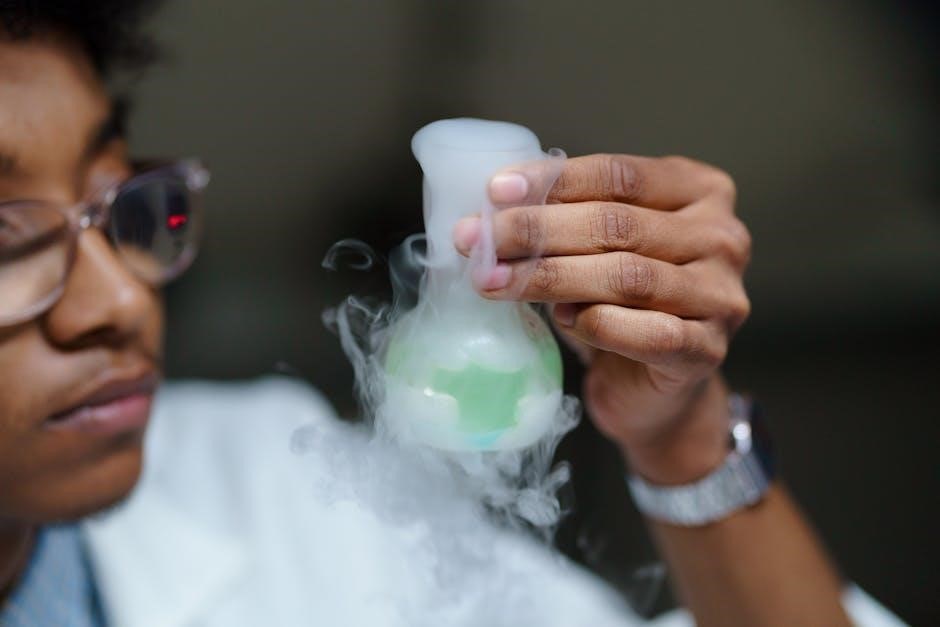
Types of Chemical Reactions
Chemical reactions are classified into synthesis, decomposition, single replacement, double replacement, and combustion. Each type involves distinct processes, such as combining substances or producing heat and light.
3.1 Synthesis Reactions
Synthesis reactions involve the combination of two or more reactants to form a single product. This type of reaction is fundamental in chemistry, as it illustrates how atoms bond to create new compounds. For example, hydrogen gas (H₂) reacting with oxygen gas (O₂) forms water (H₂O). These reactions are essential in industrial processes, such as the production of ammonia for fertilizers. Understanding synthesis reactions helps students grasp basic chemical principles, including stoichiometry and the conservation of mass. They are a cornerstone in both academic studies and practical applications of chemistry.
3.2 Decomposition Reactions
Decomposition reactions involve a single reactant breaking down into two or more simpler products. A classic example is hydrogen peroxide decomposing into water and oxygen: 2 H₂O₂ → 2 H₂O + O₂. These reactions often require energy input, such as heat or light. They are crucial in natural processes, like organic matter decay, and industrial applications, such as cement production. Understanding decomposition reactions aids in grasping chemical principles like bond breaking and energy transfer. They also illustrate how substances can be transformed for practical uses, making them vital in both academic studies and real-world applications.
3.3 Single Replacement Reactions
A single replacement reaction occurs when one element displaces another in a compound, producing a new compound and a free element. The general form is A + BC → AC + B. For example, zinc metal reacting with hydrochloric acid produces zinc chloride and hydrogen gas: Zn + 2 HCl → ZnCl₂ + H₂. These reactions often involve metals displacing hydrogen or halogens. The activity series predicts which elements can displace others, with more reactive elements displacing less reactive ones. Single replacement reactions are fundamental in understanding chemical reactivity and are widely used in industrial processes and laboratory experiments.
3.4 Double Replacement Reactions
A double replacement reaction involves two compounds exchanging ions to form two new compounds. The general form is AB + CD → AD + CB. For example, sodium sulfate reacting with barium chloride produces barium sulfate and sodium chloride: Na₂SO₄ + BaCl₂ → BaSO₄ + 2 NaCl. These reactions often result in the formation of a precipitate, gas, or water. Identifying the solubility of compounds is key to predicting the products. Double replacement reactions are crucial in various industrial applications, such as water softening and the manufacture of fertilizers, and are a cornerstone of understanding ionic interactions in chemistry.
3.5 Combustion Reactions
A combustion reaction involves a substance reacting with oxygen, typically from the air, to produce heat and light. The general form is fuel + oxygen → carbon dioxide + water. For example, methane burns as CH₄ + 2 O₂ → CO₂ + 2 H₂O. Combustion reactions are exothermic, releasing energy, and are vital for energy production, transportation, and heating. They also occur in biological processes, such as respiration. Understanding combustion is crucial for optimizing industrial processes, reducing emissions, and developing cleaner energy technologies. These reactions drive many everyday applications, from car engines to power plants, making them a cornerstone of modern society.
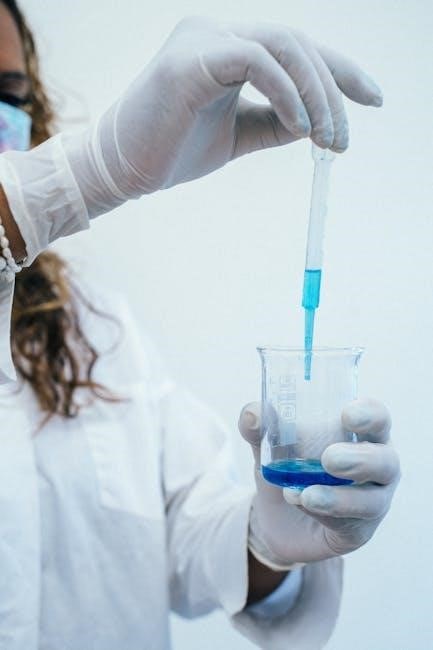
Balancing Chemical Equations
Balancing chemical equations ensures the law of conservation of mass by adjusting coefficients to equalize reactants and products. It involves systematic steps to achieve equilibrium.
4.1 Steps to Balance Equations
Balancing chemical equations involves a systematic approach to ensure the number of atoms for each element is equal on both sides. Start by identifying the number of atoms of each element in reactants and products. Use coefficients, which are numbers placed in front of formulas, to balance one element at a time. Begin with elements that appear only once and progress to those appearing multiple times. Polyatomic ions should be treated as single units. Finally, double-check the balance by counting atoms on both sides to ensure the equation is balanced and follows the law of conservation of mass.
4.2 Practice Examples
Practicing with real examples is crucial for mastering chemical equation balancing. For instance, consider the reaction:
2 NaBr + 1 Ca(OH)₂ → 1 CaBr₂ + 2 NaOH.
Here, sodium bromide reacts with calcium hydroxide to produce calcium bromide and sodium hydroxide. Each side has 2 Na, 2 Br, 1 Ca, 2 O, and 2 H, making it balanced. Another example:
CH₄ + 2 O₂ → CO₂ + 2 H₂O.
Methane burns in oxygen to form carbon dioxide and water. Ensure all atoms are balanced by adjusting coefficients. Start with simple reactions, then progress to more complex ones, such as decomposition or combustion reactions, to build confidence and skill.
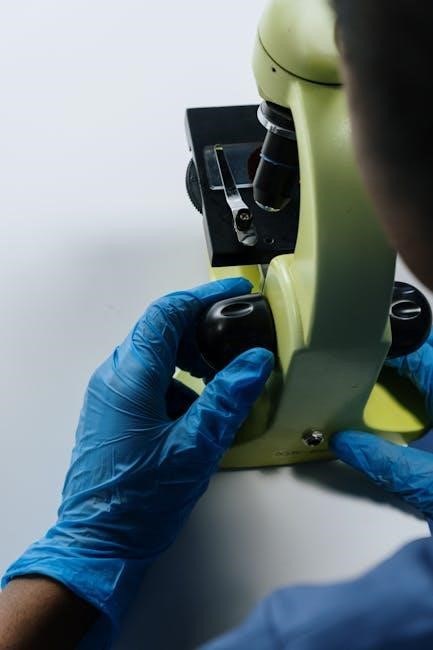
Reaction Mechanisms
A reaction mechanism outlines the step-by-step process by which reactants transform into products, including transition states and intermediates. It explains the pathway and molecular details of the reaction.
5.1 What is a Reaction Mechanism?
A reaction mechanism is a detailed, step-by-step explanation of how a chemical reaction occurs. It describes the sequence of events, including the formation of intermediates and transition states, that lead from reactants to products. A mechanism provides insight into the molecular processes underlying the reaction, such as bond-breaking and bond-forming, and helps predict reaction rates and outcomes. Unlike a balanced chemical equation, which only shows the starting and ending materials, a mechanism reveals the pathway and molecular interactions involved. This understanding is crucial for controlling and optimizing reactions in various fields, from organic synthesis to industrial processes.
5.2 Steps in a Reaction Mechanism
A reaction mechanism outlines the sequence of steps through which reactants are converted into products. It typically begins with the initiation step, where a molecule breaks down or forms a reactive intermediate. This is followed by the propagation step(s), where the intermediate reacts further, often in a chain-like process. Finally, the termination step occurs, where intermediates combine or are neutralized, ending the reaction. Each step includes details about molecular interactions, transition states, and energy changes. Understanding these steps helps clarify how reactions proceed and how their rates can be influenced, making mechanisms essential for predicting and controlling chemical processes.
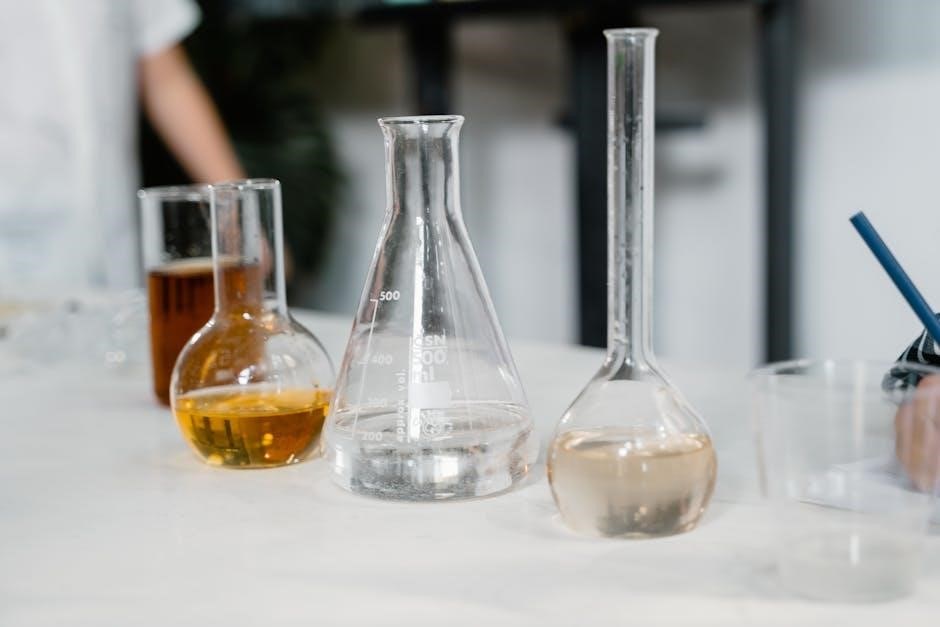
Chemical Kinetics
Chemical kinetics studies reaction rates and factors influencing them, such as concentration, surface area, temperature, and catalysts, aiding in understanding and controlling reaction processes effectively.
6.1 Reaction Rate
The reaction rate measures how quickly reactants are consumed or products formed over time. It is influenced by concentration, surface area, temperature, and catalysts. Higher concentration or temperature typically increases the rate, while a catalyst speeds it without being consumed. Understanding reaction rates helps predict and control chemical processes in laboratories and industries, ensuring efficiency and safety. Accurate rate measurements are crucial for optimizing reactions and understanding reaction mechanisms.
6.2 Factors Affecting Reaction Rate
The rate of a chemical reaction can be influenced by several factors. Increasing the concentration of reactants or raising the temperature generally accelerates the reaction, as particles move faster and collide more frequently. A larger surface area of reactants also enhances the rate by exposing more particles to potential collisions. Conversely, lowering temperature or reducing reactant concentration slows the reaction. These factors are crucial for controlling and predicting reaction rates in both laboratory experiments and industrial processes, allowing chemists to optimize conditions for desired outcomes.
6.3 Catalysts and Their Role
Catalysts are substances that accelerate chemical reactions without being consumed in the process. They work by lowering the activation energy required for the reaction to occur, allowing the reaction to proceed more efficiently. Catalysts are essential in many industrial processes, such as in the production of chemicals, fuels, and pharmaceuticals. They can be solids, liquids, or gases, and their effectiveness depends on factors like surface area and chemical composition. Using catalysts not only speeds up reactions but also reduces the energy required, making processes more economical and environmentally friendly. They play a vital role in advancing technological and chemical advancements.

Thermodynamics in Chemical Reactions
Thermodynamics in chemical reactions involves the study of energy changes, classifying reactions as endothermic (absorbing heat) or exothermic (releasing heat), and understanding energy transfer principles.
7.1 Endothermic and Exothermic Reactions
Endothermic reactions absorb heat from the surroundings, often resulting in a temperature drop. Exothermic reactions release heat, increasing the temperature. These classifications are based on energy flow. Both types are governed by thermodynamic laws. Endothermic reactions require energy input, while exothermic reactions release energy. Understanding these concepts helps predict reaction direction and energy changes. Real-world applications include industrial processes, energy storage, and biological systems. Accurate identification and analysis of endothermic and exothermic reactions are crucial for controlling chemical processes and optimizing energy use.
7.2 Activation Energy
Activation energy is the minimum energy required for reactants to initiate a chemical reaction. It represents the energy barrier that must be overcome for the reaction to occur. Higher activation energy means slower reactions, while lower activation energy accelerates them. Catalysts reduce activation energy by providing an alternative reaction pathway. Understanding activation energy is crucial for controlling reaction rates and optimizing processes. It is a key concept in reaction kinetics and thermodynamics, influencing how reactions proceed and the energy changes involved. This energy barrier determines whether a reaction is spontaneous or requires external input to occur.

Stoichiometry
Stoichiometry is the quantitative study of reactants and products in chemical reactions. It involves mole ratios, limiting reactants, and percent yield, ensuring accurate calculations and experimental results.
8.1 Mole Ratios
Mole ratios are essential in stoichiometry, representing the relationship between reactants and products in a balanced chemical equation. By converting masses to moles using molar masses, these ratios enable precise calculations of required quantities. For example, in the reaction 2 NaBr + 1 Ca(OH)2 → 1 CaBr2 + 2 NaOH, the mole ratio of NaBr to Ca(OH)2 is 2:1. Accurate mole ratio calculations ensure efficient use of reactants and predict product yields, making them a cornerstone of chemical experimentation and industrial processes.
8.2 Limiting Reactants
A limiting reactant determines the maximum amount of product that can be formed in a chemical reaction. It is the reactant that is completely consumed first, halting the reaction even if other reactants remain. Identifying the limiting reactant involves comparing mole ratios of reactants to their stoichiometric coefficients in the balanced equation. For example, in 2 NaBr + Ca(OH)₂ → CaBr₂ + 2 NaOH, if NaBr is present in less than a 2:1 ratio to Ca(OH)₂, NaBr is the limiting reactant. Understanding limiting reactants is critical for optimizing reactions and predicting yields in laboratory and industrial settings.
8.3 Percent Yield
Percent yield is the ratio of the actual yield of a product to its theoretical yield, expressed as a percentage. It helps evaluate the efficiency of a chemical reaction and identify potential losses. Theoretical yield is calculated using stoichiometry, while actual yield is measured experimentally. For example, if a reaction produces 5 grams of a product when 10 grams are expected, the percent yield is 50%. Factors like side reactions, incomplete reactions, and impurities can lower the yield. Understanding percent yield is crucial for optimizing reactions in both laboratory and industrial settings, ensuring cost-effectiveness and resource efficiency.
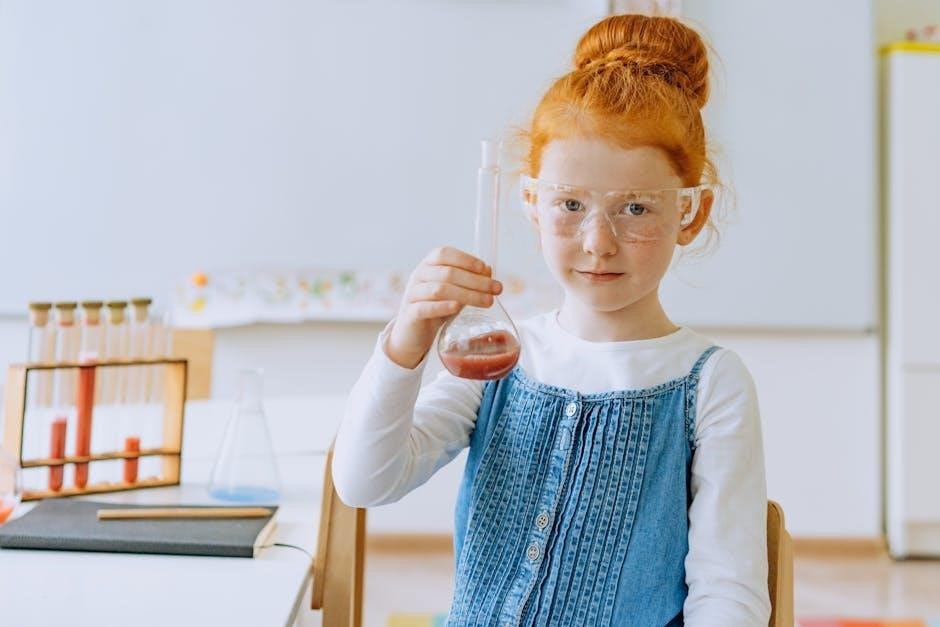
Environmental Impact of Chemical Reactions
Chemical reactions in industries release pollutants, affecting ecosystems and human health. Green chemistry practices aim to minimize waste and reduce harmful emissions, promoting sustainable development and environmental safety.
9.1 Industrial Applications
Chemical reactions are pivotal in industrial processes, driving the production of essential materials like fertilizers, plastics, and fuels. These reactions are scaled up for mass production, ensuring efficiency and cost-effectiveness. For instance, the Haber process synthesizes ammonia for fertilizers, while cracking processes refine petroleum into usable products. Industries rely on controlled reaction conditions, such as temperature and pressure, to optimize yields and minimize waste.
The development of catalysts further enhances industrial applications by speeding up reactions and reducing energy consumption. However, these processes often generate pollutants, highlighting the need for sustainable practices to mitigate environmental impact while maintaining productivity.
9.2 Green Chemistry
Green chemistry emphasizes sustainable practices to minimize environmental impact by reducing waste, conserving resources, and avoiding toxic substances. It promotes the design of chemical reactions that are energy-efficient and use renewable materials. Traditional methods often generate hazardous byproducts, but green chemistry seeks to eliminate or reduce these through innovative solutions. For example, alternative solvents and catalysts can enhance reaction efficiency while being safer for the environment. This approach aligns with global efforts to combat pollution and climate change, making it a critical focus in modern chemical research and industrial applications.
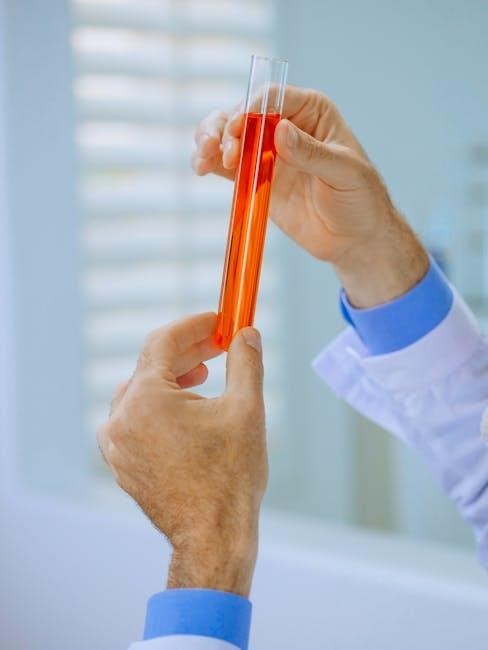
Laboratory Practices
Laboratory practices involve safe handling of chemicals, proper equipment use, accurate measurements, and detailed record-keeping to ensure reliable and reproducible experimental results in controlled settings.
10.1 Safety Procedures
Safety procedures are essential in laboratory settings to minimize risks and prevent accidents. Key practices include wearing personal protective equipment (PPE) like gloves, goggles, and lab coats to protect against chemical exposure. Proper handling of chemicals, including reading labels carefully and using fume hoods for volatile substances, is critical. Students should be trained in emergency procedures, such as using fire extinguishers, spill cleanup protocols, and knowing the location of safety showers and eyewash stations. Adhering to these guidelines ensures a secure environment for conducting experiments and learning about chemical reactions responsibly.
10.2 Common Laboratory Equipment
Essential laboratory equipment includes beakers, flasks, and test tubes for containing substances during reactions. Bunsen burners provide controlled heat, while glassware like pipettes and burettes enable precise liquid measurements. Lab stands and clamps hold equipment in place, and thermometers monitor temperatures. Crucibles and tongs are used for high-temperature reactions, and fume hoods ensure safe handling of volatile chemicals. These tools are vital for conducting experiments safely and efficiently, allowing students to explore chemical reactions and their principles hands-on. Proper use and maintenance of this equipment are crucial for accurate results and a safe learning environment.
10.3 Conducting Controlled Experiments
Conducting controlled experiments involves carefully planning and executing procedures to test hypotheses. Start by defining variables and establishing controls to isolate factors affecting the reaction. Use precise measurements with tools like thermometers and timers to ensure accuracy. Document observations thoroughly, noting colors, odors, and physical changes. Safety protocols, such as wearing PPE and using fume hoods, are essential. After the experiment, analyze data to draw conclusions and assess reproducibility. Proper cleanup and waste disposal are critical to maintain a safe environment. Controlled experiments allow for reliable insights into chemical reactions, enabling students to validate scientific principles and refine their understanding of chemical processes.
Study Tips for Mastering Chemical Reactions
Mastering chemical reactions requires consistent practice and understanding of key concepts. Focus on balancing equations, memorizing reaction types, and using visual aids like diagrams to enhance learning. Regular review and solving practice problems will reinforce comprehension and improve problem-solving skills.
11.1 Effective Note-Taking
Effective note-taking is crucial for mastering chemical reactions. Organize your notes by reaction types, mechanisms, and key concepts. Use symbols and abbreviations to simplify complex information. Highlight or underline important terms like reactants, products, and catalysts. Prioritize understanding over rote copying, focusing on why reactions occur rather than just memorizing them. Review your notes regularly, filling in gaps and clarifying doubts. Use flashcards for quick revision of reaction types and equations. Incorporate diagrams to visualize reaction mechanisms and processes. Lastly, compare your notes with study guides or textbooks to ensure accuracy and completeness.
11.2 Practicing Past Exams
Practicing past exams is an excellent way to prepare for chemical reaction questions. It helps identify weak areas and improves problem-solving skills. Start by attempting questions without looking at solutions, then review answers to understand mistakes. Focus on balancing equations, identifying reaction types, and applying stoichiometry. Simulate exam conditions to enhance time management. Use past papers to familiarize yourself with common question formats, such as multiple-choice or open-response questions. Regularly review and practice to build confidence and fluency in tackling chemical reaction problems. This method ensures you are well-prepared for exams and can apply concepts effectively under pressure.
11.3 Using Visual Aids
Visual aids like diagrams, flowcharts, and videos are powerful tools for mastering chemical reactions. They help students visualize abstract concepts, such as reaction mechanisms and molecular interactions. For example, diagrams can illustrate the steps in a synthesis reaction, while videos can demonstrate lab experiments safely. Flowcharts are useful for mapping out the classification of reaction types. Using color-coded charts or interactive simulations can also enhance understanding and retention. Incorporating these tools into study routines makes complex topics more engaging and easier to grasp. They are especially helpful for visual learners, providing a clear and structured way to approach chemical reaction problems.
